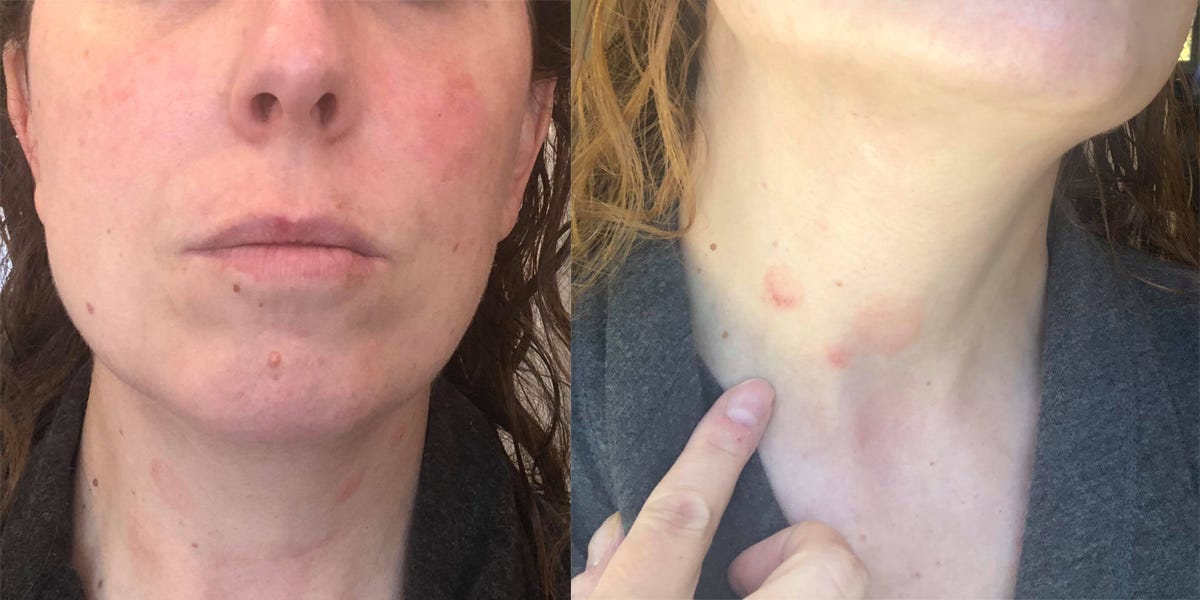
Jessica Bortz Schaap
- Some coronavirus patients — particularly those with long-lasting symptoms — have reported dermatological problems including hives, lesions, and red, scaly rashes.
- A new report from Massachusetts General Hospital identified skin issues among more than 300 coronavirus patients from April to August.
- Doctors suspect these rashes may be the result of persistent inflammation in the body.
- Visit Business Insider’s homepage for more stories.
Laura Romero thought the red rash she spotted on her arm in September was an allergic reaction to her laundry detergent. But its placement was puzzling: The rash was only concentrated in a small patch near her right elbow.
“I’d never had a rash like that before,” Romero, a 28-year-old who lives near San Antonio, Texas, told Business Insider. “It was very itchy and there were little bumps on it. It kind of looked like eczema, but I don’t have a history of eczema.”
Romero is a coronavirus “long-hauler” — a patient with long-lasting symptoms. She was diagnosed with COVID-19 on August 17, with symptoms including congestion, vomiting, and body aches. She still suffers from nausea, headaches, and fatigue.
Like Romero, many long-haulers are reporting dermatological problems including hives, lesions, and red, scaly rashes. Coronavirus patients — long-haulers and otherwise — have also reported redness and swelling on their feet, a condition that has earned the nickname “COVID toes.” Sometimes, these issues appear in conjunction with early symptoms; in other cases, it can take weeks or months for skin problems to manifest after a person is diagnosed.
From April to August, physicians at Massachusetts General Hospital documented more than 300 coronavirus patients with skin problems, according to a new report presented at the annual meeting of the European Academy of Dermatology and Venereology.
On average, the report found, these skin conditions lasted around 12 days. "COVID toes" lasted slightly longer — around 15 days in lab-confirmed cases — though two patients exhibited the symptom for more than 130 days. Scaly rashes typically lasted around 20 days in confirmed cases.
"Our findings reveal a previously unreported subset of patients with long-standing skin symptoms from COVID-19, in particular those with COVID toes," Dr. Esther Freeman, the hospital's director of global health dermatology, said in a statement. "This data adds to our knowledge about the long-term effects of COVID-19 in different organ systems."
Long-haulers may be prone to skin issues
Romero said her rash has persisted for more than seven weeks. Lately, it has crept up towards her forearm, but it hasn't appeared on any other part of her body. As a surgical assistant, Romero has found the rash particularly irritating, since her protective gown rubs against her skin.
"It started getting to the point where it was getting really itchy throughout the day," she said. "It would get open sores, I guess from scratching it so much. Then it was painful after that because I kept scratching it."

PanLaos/Getty Images
Eczema lotion helps relieve some of the discomfort, she said, but the redness won't go away.
Some evidence suggests skin conditions may be more common among long-haulers than the average coronavirus patient.
In an August survey of nearly 4,000 symptomatic COVID-19 patients, only 36 said they developed a rash during their first 10 days of symptoms. But in a July survey of more than 1,500 long-haulers, 247 patients said they'd had a rash at some point during their illness. Around 170 long-haulers also said they'd experienced swollen toes or feet, but the condition has been more frequently associated with COVID-19 cases that show no other signs of illness.
"Many patients are developing these toe lesions well after their infection, or they're otherwise completely asymptomatic, except for the toes," Freeman recently told AARP.
A possible inflammatory response
Jessica Bortz Schaap never tested positive for the coronavirus, but her doctor gave her a presumed diagnosis in July. She'd developed many classic COVID-19 symptoms — fever, sore throat, joint paint, difficulty breathing, and fatigue — but her test came back negative. (Her doctor suspected she was tested too early.)
By October, Schaap's symptoms had mostly gone, but a strange rash had appeared on her neck.
"It looks almost like a cigarette burn," Schaap, a 42-year-old in Louisville, Kentucky, told Business Insider. "It's kind of red and it's just these perfect little circles that break out."
One potential explanation for this is that the coronavirus may directly damage skin cells. It's also possible that rashes and lesions could result from tiny blood clots in the skin. Some research has indicated that COVID-19 is a vascular disease instead of a respiratory one, meaning it can travel through the blood vessels.
But doctors have another theory as to why rashes form after several weeks or months: Many long-haul cases likely stem from an aggressive immune response to the virus, which can trigger persistent inflammation.
"The skin is potentially a visible window into inflammation that could be going on in the body," Freeman said. "We encourage clinicians taking care of patients with COVID-19 to ask about and evaluate any skin symptoms."
